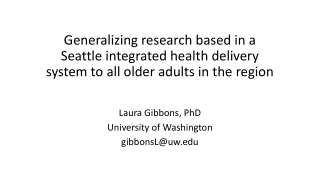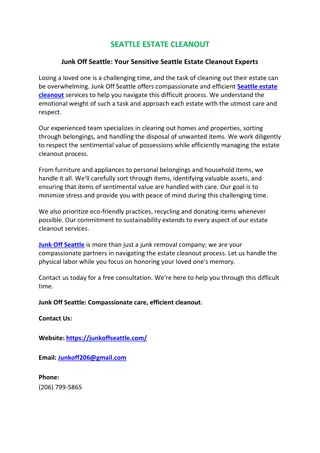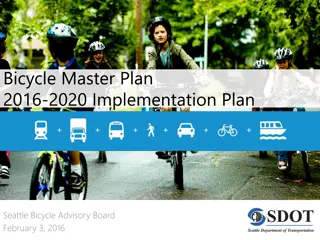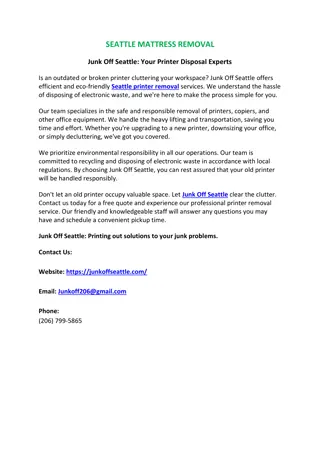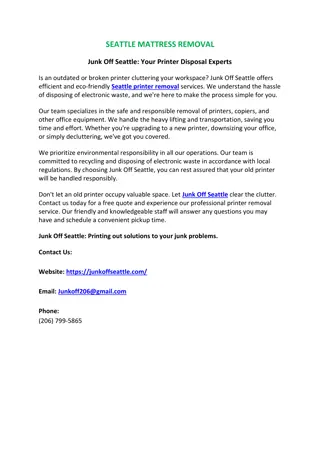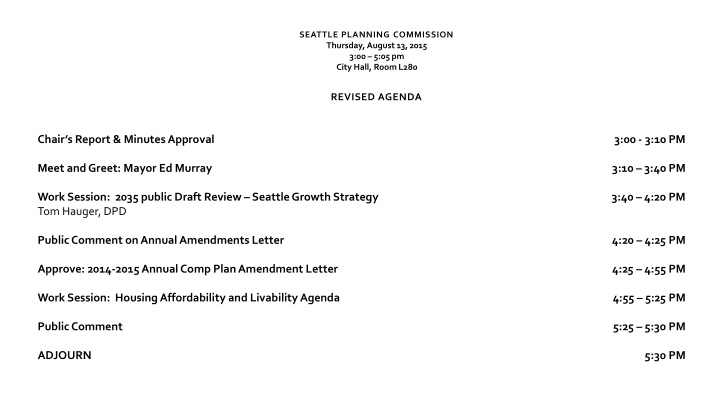
Seattle Planning Commission Meeting Agenda and Growth Strategy Review
Explore the agenda of the Seattle Planning Commission meeting on August 13, 2015, including discussions on the city's growth strategy, housing affordability, public comments, and more. Learn about policy recommendations related to urban villages, transportation planning, and strategies to address displacement concerns.
Download Presentation

Please find below an Image/Link to download the presentation.
The content on the website is provided AS IS for your information and personal use only. It may not be sold, licensed, or shared on other websites without obtaining consent from the author. If you encounter any issues during the download, it is possible that the publisher has removed the file from their server.
You are allowed to download the files provided on this website for personal or commercial use, subject to the condition that they are used lawfully. All files are the property of their respective owners.
The content on the website is provided AS IS for your information and personal use only. It may not be sold, licensed, or shared on other websites without obtaining consent from the author.
E N D
Presentation Transcript
SEATTLE PLANNING COMMISSION Thursday, August 13, 2015 3:00 5:05 pm City Hall, Room L280 REVISED AGENDA Chair s Report & Minutes Approval 3:00 - 3:10 PM Meet and Greet: Mayor Ed Murray 3:10 3:40 PM Work Session: 2035 public Draft Review Seattle Growth Strategy Tom Hauger, DPD 3:40 4:20 PM Public Comment on Annual Amendments Letter 4:20 4:25 PM Approve: 2014-2015 Annual Comp Plan Amendment Letter 4:25 4:55 PM Work Session: Housing Affordability and Livability Agenda 4:55 5:25 PM Public Comment 5:25 5:30 PM ADJOURN 5:30 PM
Seattle Growth Strategy Current Policy in Public Draft GS1.5 Monitor urban centers and villages to track changes over time in the number of housing units and jobs, population and public investments, and use this information to make decisions about conducting further planning or providing additional investments to help meet the needs of residents in these locations. Staff Recommendation as a replacement policy for GS1.5 Acknowledge that not all Urban Villages have the same needs. Monitor neighborhood-level demographics and indicators, and use this information to make equitable planning and investment decisions.
Seattle Growth Strategy Current Policy in Public Draft GS2.4 Coordinate planning for transportation, utilities, open space and other public services to meet the anticipated growth and increased density. Staff Recommendation as replacement policy for GS2.4 Coordinate planning for transportation, utilities, open space and other public services to meet the needs of the community you wish to serve.
Seattle Growth Strategy Current Policy in Public Draft on Displacement Concern - GS1.6 Monitor development activity in areas with high potential for displacement of marginalized populations and small businesses and identify and implement strategies that can limit that displacement. GS2.9 Use zoning and other planning tools in places where growth and development are expected to shape the amount and pace of growth in ways that will control displacement of marginalized populations, community services and institutions. Staff recommendation to replace policy for GS1.6/2.9. Seek to provide equitable access to Urban Villages and Centers where transit service and community amenities are plentiful. Encourage targeted use of incentive zoning, cultural district overlays, and other citywide investment tools to prevent displacement of marginalized populations and culturally significant institutions and businesses.
Seattle Growth Strategy Current Policy in Public Draft that Define Boundary of Urban Villages/Centers GS2.3 Establish boundaries for urban centers, urban villages, and manufacturing/industrial centers that reflect existing development patterns, intended community characteristics, and recognized neighborhood areas. GS2.11 Permit varying sizes of urban villages based on local conditions, but limit sizes so that most village areas are within walking distance from employment and service areas in the village. GS2.12 Reflect the area that is generally within a ten-minute walk of frequent light rail stations in urban villages. Staff Recommendation on replacement of GS2.3 and GS2.12 with the following. Keep GS2.11? GS2.3 Establish boundaries for urban centers, urban villages, and manufacturing/industrial centers that reflect existing development patterns, intended community characteristics, and the 10 minute walkshed(defined below) from frequent and reliable transit as defined by policy GS2.?? GS2.?? Define frequent and reliable transit as: 1. light rail stations; 2. Places where two corridors that currently provide frequent transit service intersect, as shown in either red, orange, or yellow on the Frequent Transit Network map (Figure 4-1 in the Seattle Transit Master Plan) as updated to show actual 2012 frequent transit service levels; 3. Existing multimodal hubs and transportation centers shown in Figure 5-5 in the Seattle Transit Master Plan GS2.???? amendment to the Comprehensive Plan. Boundaries of existing Urban Villages and Urban Centers may only be revisited through a community planning process and an
SPC letter re: 2014/15 Proposed Amendments to Comp Plan Proposed FLUM amendments
Central Area Update Parcels include: 700 22nd Ave. (within UV) E. Union Street 2002, 2006, 2008, 2012, 2016, 2018 1412 20th Ave. E. John Street 2001, 2015
Lake City Update Parcels Include: 1. NE 125th St. 2611, 2700, 2707, 2727, 2805 2. 28th Ave. NE 12501, 12531 3. 27th Ave. NE 12509
Morgan Junction Update Parcel Included: 4201 SW. Juneau Street
U-District Update Parcels Include: Several
SPC letter re: 2014/15 Proposed Amendments to Comp Plan 1. Central Area Neighborhood Plan Planning Commission Recommendation: Adopt with modification Change since March none 2. Lake City Neighborhood Plan Planning Commission Recommendation: Adopt Change since March none
SPC letter re: 2014/15 Proposed Amendments to Comp Plan 3. Morgan Junction Neighborhood Plan Planning Commission Recommendation: Adopt Change since March some revised language 4. University District Update Planning Commission Recommendation: Adopt with modifications Change since March revised language, no FLUM change
SPC letter re: 2014/15 Proposed Amendments to Comp Plan 5. Downtown Neighborhood Plan Updates Planning Commission Recommendation: Adopt Change since March none
Housing Affordability and Livability Agenda SPC approach Two top near-term priorities for Commission to review and comment on: Build Affordability as we grow: Commercial Linkage Fee and Mandatory Inclusionary Housing (with upzones in proportion to requirements) Increase Opportunities for Multifamily Housing, including:
Housing Affordability and Livability Agenda SPC approach Increase the amount of land zoned for MF housing in urban villages and walksheds (MF.1) Expand the boundaries of Urban Villages to reflect walksheds for transit, amenities and services (MF.2) Increase housing options on single family zoned land within Urban Villages (MF.3) rezone SF to RSL or Lowrise Add multifamily zoning to create transitions next to more intensive zones
Housing Affordability and Livability Agenda SPC approach Second level priority and related: Expand the Multifamily Property Tax Exemption Program Comprehensive Parking Reform Prevent displacement of low-income residents (tenants and homeowners)
Housing Affordability and Livability Agenda timing Select Committee on Housing Affordability fall 2015 legislation: Work Plan Resolution Mandatory Inclusionary Zoning, Commercial Linkage Fee Resolution Commercial Linkage Fee Regulatory Framework Council Bill
Housing Affordability and Livability Agenda timing Work Plan Resolution Establishes City s affordable Housing objectives based on HALA recs Sets out multi year work program for implementation of recs Requests state level changes Concurs with housing targets that guided HALA recs Timing 9/9 Public Hearing 9/18 Discussion 9/21 Committee vote 9/28 Full Council vote
Housing Affordability and Livability Agenda timing Mandatory Inclusionary Zoning (MIZ), Commercial Linkage Fee (CLF) Resolution Timing 9/9 Public Hearing 9/18 Discussion 9/21 Committee vote 9/28 Full Council vote Establish intent to consider future upzones to implement MIZ and CLF Establish expectations for planning and outreach that must precede Council action Identify other HALA recommended land use regulatory changes that Council will consider
Housing Affordability and Livability Agenda timing Timing 9/18 Briefing 9/30 Public Hearing 10/5 Discussion 10/12 Committee vote 11/2 Full Council vote Commercial Linkage Fee Bill New Chapter in Seattle Muni Code that establishes a commercial linkage fee program Requirements of chapter not applicable to new development until future upzones occur.
Housing Affordability and Livability Agenda Commercial Linkage Fee Mandatory requirement of new commercial construction to pay a per square foot fee to the City for the production and preservation of affordable housing Fees will fund housing at 0 80% AMI but primarily at or below 60% AMI Fees based on value of upzones and vary by market and construction type
Housing Affordability and Livability Agenda Commercial Linkage Fee Under 85 rezone specified areas to provide additional capacity for commercial development Highrise additional floor area (1 FAR) equivalent to site size; fees based on existing Incentive Zoning for affordable housing Phased in over 3 years, fee schedule set for 10 years (indexed for CPI) with changes subject to Mayor and Council undertaking a specified Technical Review Committee process, existing IZ will remain until CLF is implemented


